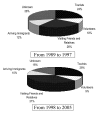Imported malaria in a cosmopolitan European city: a mirror image of the world epidemiological situation
- PMID: 18397524
- PMCID: PMC2362124
- DOI: 10.1186/1475-2875-7-56
Imported malaria in a cosmopolitan European city: a mirror image of the world epidemiological situation
Abstract
Background: International travel and migration have been related with an increase of imported malaria cases. There has been considerable immigration to Barcelona from low-income countries (LIC) in recent years. The objective is to describe the epidemiology and to determine the trends of the disease in Barcelona.
Methods: Analysis of the cases notified among city residents between 1989 and 2005. Patients were classified as: tourists, voluntary workers, resident immigrants (visiting friends and relatives, VFR) and recently arrived immigrants. An analysis was conducted using the chi2 test and comparison of means. As a measure of association we calculated the Relative Risk (RR) and Odds Ratio (OR) with a Confidence Interval of 95% (CI) and carried out a trends analysis.
Results: Of the total of 1,579 imported cases notified, 997 (63.1%) lived in Barcelona city, and 55.1% were male. The mean age of patients was 32.7 years. The incidence increased from 2.4 cases/100,000 in 1989 to 3.5 cases/100,000 in 2005 (RR 1.46 CI:1.36-1.55). This increase was not statistically significant (trends analysis, p = 0.36). In terms of reason for travelling, 40.7% were VFR, 33.6% tourists, 12.1% voluntary workers and 13.6% were recently arrived immigrants. The most frequent species found was Plasmodium falciparum (71.3%), mainly in visitors to Africa (OR = 2.3, CI = 1.7-3.2). The vast majority (82.2%) had had some contact with Africa (35.9% with Equatorial Guinea, a Spanish ex-colony) and 96.6% had not completed chemoprophylaxis. Six deaths were observed, all tourists who had travelled to Africa and not taken chemoprophylaxis (3.9% fatality rate).
Conclusion: Over the period studied there is an increase in malaria incidence, however the trend is not statistically significant. Lack of chemoprophylaxis compliance and the association between Africa and P. falciparum are very clear in the imported cases. Most of the patients with malaria did not take chemoprophylaxis.
Figures





Similar articles
-
Imported malaria among African immigrants: is there still a relationship between developed countries and their ex-colonies?Malar J. 2009 May 22;8:111. doi: 10.1186/1475-2875-8-111. Malar J. 2009. PMID: 19463171 Free PMC article.
-
Epidemiology of imported malaria among children and young adults in Barcelona (1990-2008).Malar J. 2011 Nov 25;10:347. doi: 10.1186/1475-2875-10-347. Malar J. 2011. PMID: 22118531 Free PMC article.
-
Imported malaria cases: the connection with the European ex-colonies.Malar J. 2019 Dec 4;18(1):397. doi: 10.1186/s12936-019-3042-1. Malar J. 2019. PMID: 31801538 Free PMC article.
-
[Clinico-epidemiological analysis of imported malaria in Donetsk region (1979-1997)].Ter Arkh. 1998;70(11):43-5. Ter Arkh. 1998. PMID: 9949459 Review. Russian.
-
[Imported malaria in children in France].Arch Pediatr. 2003 Sep;10(9):758-65. doi: 10.1016/s0929-693x(03)00396-8. Arch Pediatr. 2003. PMID: 12972201 Review. French.
Cited by
-
Risk factors for mortality from imported falciparum malaria in the United Kingdom over 20 years: an observational study.BMJ. 2012 Mar 27;344:e2116. doi: 10.1136/bmj.e2116. BMJ. 2012. PMID: 22454091 Free PMC article.
-
The malaria candidate vaccine liver stage antigen-3 is highly conserved in Plasmodium falciparum isolates from diverse geographical areas.Malar J. 2009 Oct 29;8:247. doi: 10.1186/1475-2875-8-247. Malar J. 2009. PMID: 19874576 Free PMC article.
-
Population-based laboratory surveillance of imported malaria in metropolitan Calgary, 2000-2011.PLoS One. 2013 Apr 15;8(4):e60751. doi: 10.1371/journal.pone.0060751. Print 2013. PLoS One. 2013. PMID: 23613742 Free PMC article.
-
Evidence of malarial chemoprophylaxis among travellers who died from malaria: a systematic review and meta-analysis.Malar J. 2023 Nov 25;22(1):359. doi: 10.1186/s12936-023-04794-x. Malar J. 2023. PMID: 38001503 Free PMC article.
-
Imported malaria among African immigrants: is there still a relationship between developed countries and their ex-colonies?Malar J. 2009 May 22;8:111. doi: 10.1186/1475-2875-8-111. Malar J. 2009. PMID: 19463171 Free PMC article.
References
-
- Roll Back Malaria. World Health Organization and UNICEF; 2005. World Malaria Report 2005.http://www.rbm.who.int/wmr2005/html/exsummary_en.htm [Cited 2007 august 8]
-
- Legros F, Danis M. Surveillance of malaria in European Union countries. Euro Surveill. 1998;3:45–47. - PubMed
-
- Breman JG, Alilio MS, Mills A. Conquering the intolerable burden of malaria: what's new, what's needed: a summary. Am J Trop Med Hyg. 2004;71:1–15. - PubMed
MeSH terms
LinkOut - more resources
Full Text Sources
Medical
Research Materials

